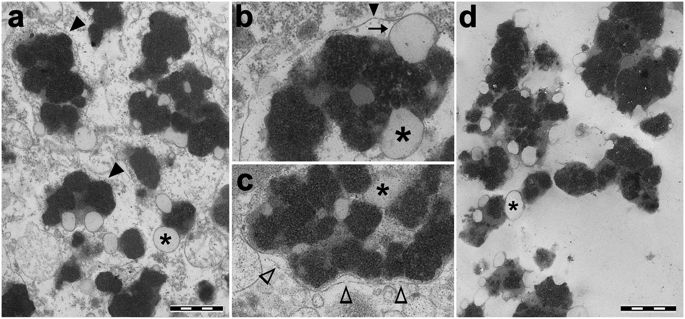npj Parkinson's Disease ( IF 9.304 ) Pub Date : 2018-06-05 , DOI: 10.1038/s41531-018-0050-8 Fabio A. Zucca , Renzo Vanna , Francesca A. Cupaioli , Chiara Bellei , Antonella De Palma , Dario Di Silvestre , Pierluigi Mauri , Sara Grassi , Alessandro Prinetti , Luigi Casella , David Sulzer , Luigi Zecca

|
During aging, neuronal organelles filled with neuromelanin (a dark-brown pigment) and lipid bodies accumulate in the brain, particularly in the substantia nigra, a region targeted in Parkinson’s disease. We have investigated protein and lipid systems involved in the formation of these organelles and in the synthesis of the neuromelanin of human substantia nigra. Membrane and matrix proteins characteristic of lysosomes were found in neuromelanin-containing organelles at a lower number than in typical lysosomes, indicating a reduced enzymatic activity and likely impaired capacity for lysosomal and autophagosomal fusion. The presence of proteins involved in lipid transport may explain the accumulation of lipid bodies in the organelle and the lipid component in neuromelanin structure. The major lipids observed in lipid bodies of the organelle are dolichols with lower amounts of other lipids. Proteins of aggregation and degradation pathways were present, suggesting a role for accumulation by this organelle when the ubiquitin-proteasome system is inadequate. The presence of proteins associated with aging and storage diseases may reflect impaired autophagic degradation or impaired function of lysosomal enzymes. The identification of typical autophagy proteins and double membranes demonstrates the organelle’s autophagic nature and indicates that it has engulfed neuromelanin precursors from the cytosol. Based on these data, it appears that the neuromelanin-containing organelle has a very slow turnover during the life of a neuron and represents an intracellular compartment of final destination for numerous molecules not degraded by other systems.
中文翻译:

神经黑色素细胞器是专门的自溶酶体,可在人的衰老大脑中积聚未降解的蛋白质和脂质,并可能参与帕金森氏病
在衰老过程中,充满神经黑色素(暗褐色色素)和脂质体的神经细胞器会在大脑中堆积,尤其是在黑质(帕金森氏病的靶标区域)中。我们已经研究了参与这些细胞器的形成和人类黑质神经黑色素合成的蛋白质和脂质系统。在含神经黑色素的细胞器中发现溶酶体特征性的膜和基质蛋白的数量低于典型的溶酶体,表明酶活性降低,溶酶体和自噬体融合的能力可能受损。参与脂质转运的蛋白质的存在可能解释了细胞器中脂质体的积累和神经黑色素结构中的脂质成分。在细胞器脂质体中观察到的主要脂质是具有较低其他脂质含量的二元醇。存在聚集和降解途径的蛋白质,这表明当遍在蛋白-蛋白酶体系统不足时该细胞器的积累作用。与衰老和贮藏病有关的蛋白质的存在可能反映了自噬降解受损或溶酶体酶功能受损。对典型自噬蛋白和双膜的鉴定证明了细胞器的自噬性质,并表明其已经吞噬了细胞质中的神经黑色素前体。根据这些数据,



























 京公网安备 11010802027423号
京公网安备 11010802027423号